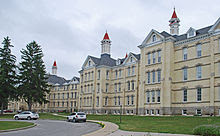(Continued from August 21,
2013 . . . )
The fight on the Omaha playground
took place on Friday. The next day, I expected to board the train for
Walsenburg, Colorado, where I’d spend the rest of the school year. But that morning,
Sister Brendan, the Omaha superior, summoned me to her office.
I
knelt by her chair as did all nuns when a superior wanted to confer with
them. It was a sign of obedience to what would be said or asked.
“Sister
Innocence,” she said, “you won’t be going to Walsenburg. Instead you’ll stay
here and teach a section of seventh graders.”
I
must have looked confused because she added, “The nun who’s been their teacher is
returning to the Mount.” I nodded, still not understanding. She riffled through
some papers on her desk and said, not looking at me, “She’ll be sent to Council
Bluffs.”
Leaving
her office, I went to the basement to do the convent laundry. Sister Mary Norbert
followed me. She asked what I knew about my new assignment.
“Nothing
really. Sister Brendan just told me I’d be teaching seventh graders because their
teacher was being reassigned to Council Bluffs.”
Norbert
grimaced. “Not reassigned. It’s not a school she’s going to. It’s a mental
facility. Saint Bernard’s. Run by the Mercy nuns.”
Now
I was totally confused.
“It’s
where the Mount sends all the nuns who’ve gone off the deep end,” she added. As
she ascended the steps, her final words drifted down to me like wisps of smoke
from dying embers. “She’s nuttier than a fruitcake. And she’s taught those
seventh graders to be Nazi storm troopers.”
This is a psychiatric hospital in Michigan.
But if you’d like to see an early photograph
of St. Bernard’s,
On
Monday morning I followed Sister Brendan up to the second floor of the grade
school. She pointed out her eighth-grade classroom on the left and then motioned
me to the door on the right. On its glass window someone has taped dark
construction paper so we couldn’t see in.
When
we entered, Sister Brendan immediately removed the construction paper, and with
seeming satisfaction, crumpled it into a ball and tossed it nonchalantly into
the wastepaper basket. Then she strode to the front of the classroom.
Meekly,
I followed, gazing nervously at the fifty-five seventh graders sitting there. Seeing
me, many smirked. Nudged one another. Gave one another a high-five. Rolled
their eyes. Whispered out of the sides of their mouths.
Out
of those mouths had tumbled the violent words that had catapulted me into the
middle of their violent circle the previous Friday. They’d certainly acted like
Nazi storm troopers then. I saw the boy who’d done the bopping; I saw the boy
who’d lain on the ice. He had two butterfly bandages on his shaved sculp.
“This
is Sister Innocence,” Sister Brendan said as I stood next to her. “She’ll teach
you the rest of the year.” When Ron asked where their “real” teacher was, Sister
Brendan said, “She’s returned to the Mount due to ill health.”
Gleefully,
twenty-eight boys and twenty-seven girls in six rows stared at me as if I were
a hen to pluck. They knew, as did I, that I was a rookie. Easy pickings.
My
heart began to pound; fear inched its way through my veins. Sister Brendan
smiled at me encouragingly and then walked out of the room, closing the door firmly
behind her.
Hearing
the latch click shut, the seventh-graders hooted. Howled. Their din hurt my
ears. “Quiet, please,” I said, over and over. I could hear the plea in my voice.
The weakness. I trembled as their voices thundered round me.
Bewildered,
I sat down at the desk and simply gazed at them. One by one. They fidgeted.
Shrugged their shoulders. Began to throw balled paper at me and to roll spitballs.
Still I stared at them, saying nothing. Slowly quiet settled round us.
Now
began the task of teaching. This was to be, I feared, a baptism by fire.
( . . . to be continued next Wednesday,
September 4.)
Psychiatric hospital from Wikipedia.






